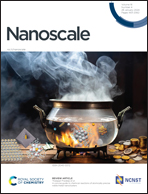Defect and interface/surface engineering synergistically modulated electron transfer and nonlinear absorption properties in MoX2 (X = Se, S, Te)@ZnO heterojunction†
Abstract
Systematic interface and defect engineering strategies have been demonstrated to be an effective way to modulate the electron transfer and nonlinear absorption properties in semiconductor heterojunctions. However, the role played by defects and interfacial strain in electron transfer at the interface of the MoX2 (X = Se, S, Te)@ZnO heterojunction remains poorly understood. Herein, using the MoX2@ZnO heterojunction, we reveal that vacancies play a critical role in the interfacial electron transfer of heterojunctions. Specifically, we present the defect and interface engineering of the MoX2@ZnO heterojunction for controlled charge transfer and electron excitation-relaxation. The experimental characterization combined with first-principles calculations showed that the presence of defects promoted the transport of photogenerated carriers at the heterojunction interface, thereby inhibiting their rapid recombination. The DFT calculation confirmed that the electron band structure, density of states and charge density distribution in the system changed after the formation of Mo–O bonds. On the basis of defects and interfacial stress and the effective charge transfer, the MoX2@ZnO heterojunction exhibited excellent excitation and emission behaviors. The nonlinear optical regulation behavior of TMDs is expected to be realized with the help of the defects and interface/surface synergistically modulated effect of ZnO nanoparticles. The local strain generation on the MoX2@ZnO heterojunction boundary provides a new method for the design of new heterogeneous materials and will be of great significance to investigate the contact physical behavior and application of metals and two-dimensional (2D) semiconductors. This work provides some inspiration for the construction of heterojunctions with rich defects and surface/interface charge transfer channels to promote tunable electron transfer dynamics, thereby achieving a good nonlinear optical conversion efficiency and efficient charge separation in optoelectronic functional materials.



 Please wait while we load your content...
Please wait while we load your content...